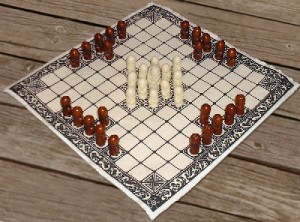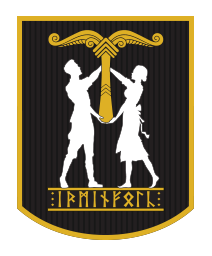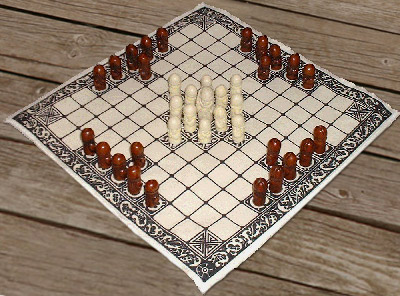 Hnefatafl (pronounced neff-e-tah-ful) is a Chess-like board game once considered to be the most respected intellectual pursuit among Norse nobles.
Hnefatafl (pronounced neff-e-tah-ful) is a Chess-like board game once considered to be the most respected intellectual pursuit among Norse nobles.
Hnefatafl was considered lost to history for almost a millennium, the only artefacts of its existence being game boards discovered at excavations, and in various obscure riddles in the Icelandic Sagas. The game remained a mystery until the British chess historian Harold J. R. Murray connected the description of a Saami game, tablut, in the diary of Swedish botanist Carl von Linné from his trip to Lapland in 1732 with the descriptions of hnefatafl in the Sagas. Murray’s hypothesis, that the Saami game of tablut was identical with hnefatafl.
Over time, many different sets of rules for Hnefatafl and sizes for game boards came about for the game, but the principal is always the same. Unlike Chess, with equal black and white sides, Hnefatafl is an asymmetrical game. One side, usually the black side, is played from the center of the board and features a defending king at the center of his pawns. The attacker, usually the white side, is made up only of pawns who begin the game on their “ships” on the perimeter of the board. It simulates a battle between a weaker force in the center of the board, surrounded and outnumbered by an attacking force.
It is played on a board with an odd number of squares in a row, with an equal number of columns and rows forming a square grid (example 9×9, 7×7, 11×11, etc).
 The surrounded side consists of a king (hnefi) and a number of mutually identical pieces called defenders. All pieces on the attacker’s side are identical, and they outnumber the defenders by 2:1. The king, who is larger than the other pieces on the board, is initially placed on the central square, the defenders are standing on the squares next to him, and the attackers are placed on squares in the outer parts of the board. The objective for the surrounded side is to break out and escape with the king, whereas the attackers win if they manage to capture the king. All pieces move any number of vacant squares in vertical or horizontal direction, like a rook in chess. A piece is captured and removed from the board if it is sandwiched between two enemy pieces, one on each side in vertical or horizontal direction.
The surrounded side consists of a king (hnefi) and a number of mutually identical pieces called defenders. All pieces on the attacker’s side are identical, and they outnumber the defenders by 2:1. The king, who is larger than the other pieces on the board, is initially placed on the central square, the defenders are standing on the squares next to him, and the attackers are placed on squares in the outer parts of the board. The objective for the surrounded side is to break out and escape with the king, whereas the attackers win if they manage to capture the king. All pieces move any number of vacant squares in vertical or horizontal direction, like a rook in chess. A piece is captured and removed from the board if it is sandwiched between two enemy pieces, one on each side in vertical or horizontal direction.
A complete set of rules typically looks like this :
- Two players may participate. One player plays the king’s side, with a king and his defenders, and the other player plays the attackers. There are either eight defenders and sixteen attackers, as in tablut, or twelve defenders and twenty-four attackers, as in tawl-bwrdd.
- The game is played on a board with 9×9 or 11×11 squares and with initial set-up as in tablut or tawl-bwrdd.
- The central square, called the throne, and the four squares in the corners are restricted and may only be occupied by the king. It is allowed for the king to re-enter the throne, and all pieces may pass the throne when it is empty. The four corner squares are hostile to all pieces, which means that they can replace one of the two pieces taking part in a capture. The throne is always hostile to the attackers, but only hostile to the defenders when it is empty. (There appear to be some variations on this point. Sometimes the throne is hostile to defenders also when the king occupies it.)
- The objective for the king’s side is to move the king to any of the four corner squares. In that case, the king has escaped and his side wins. The attackers win if they can capture the king before he escapes.
- The attackers’ side moves first, and the game then proceeds by alternate moves. All pieces move any number of vacant squares along a row or a column, like a rook in chess.
- All pieces except the king are captured if they are sandwiched between two enemy pieces, or between an enemy piece and a hostile square, along a column or a row. The two enemy pieces should either be on the square above and below or on the square to the left and to the right of the attacked piece. A piece is only captured if the trap is closed by a move of the opponent, and it is, therefore, allowed to move in between two enemy pieces. A captured piece is removed from the board and is no longer active in the play. The king may take part in captures.
- The king himself is captured like all other pieces, except when he is standing on the throne or on one of the four squares next to the throne. When the king is standing on the throne, the attackers must surround him in all four cardinal points. When he is on a square next to the throne, the attackers must occupy all surrounding squares in the four points of the compass except the throne.
For anyone wishing to try the game out a little bit, there are several on-line versions which can be played against the AI or against people over the internet. Try it here.








